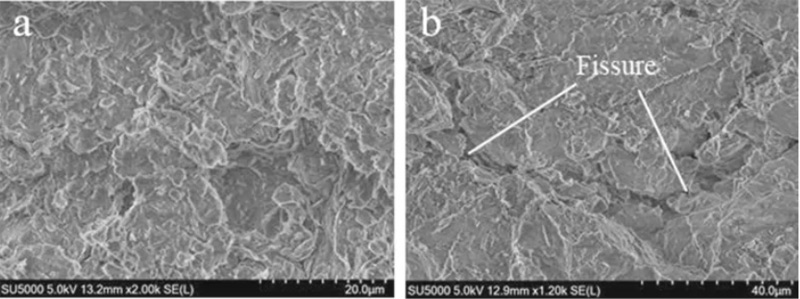Discussion
Expansion characteristics discussion
Water absorption and swelling is a process in which pores are gradually filled with water, NMR Analyzer and a process of gradually transitioning from an unsaturated state to a saturated state.
①In the initial expansion stage, the saturation is low. Due to the small soil-water contact angle, a small amount of water enters and diffuses rapidly. This part of water is mainly adsorbed between the clay mineral crystal layers, so that the space between the crystal layers expands, so the expansion rate is higher.
② As the saturation increases, the expansion and deformation of the crystal layer is completed. The migration of capillary water forms a water film, and at the same time the thickness of the electric double layer increases, causing expansion and deformation to continue.
① In the third stage, the thickness of the electric double layer no longer increases, the water gradually fills up, and the expansion tends to be stable.
Expansion and deformation discussion
In the drying stage, the shrinkage of the pores is exacerbated by the surface tension of the water, resulting in unrecoverable deformation; as the residual deformation accumulates, the expansion deformation gradually decreases.
Figure 8 is the scanning electron microscopy pictures under different cycles. After 1 cycle, the soil particles are in close contact; after 4 cycles, there are obvious cracks. Due to the loss of particle strength on the fracture surface, the force hindering lateral deformation decreases. As the number of cycles increases, the specimen breaks, weakening the expansion ability.

Discussion on pore size distribution under different water contents
As shown in Figure 6, when the water content is 19-22%, the pore volume increases greatly; when the water content is 10-19% or 22-28%, the pore volume increases slightly. After water enters, the crystal layer and the soil particles expand, the pores are filled with water, and the expansion rate is large; as the water enters continuously, the thickness of the water film reaches the maximum value, and the expansion tends to be stable. The increase in the thickness of the water film will increase the distance between the soil particles, which is the main factor of the expansion deformation of the expansive soil.
Discussion on the pore size distribution under different cycles
As shown in Fig. 7, the macropores are greatly affected by the dry-wet cycle and the micropores are not sensitive to cycle changes. There are two main reasons for the change in soil pore structure: one is the change in the position and contact state of the soil particles; the second is the dissolution of the water-soluble salt cement. During the dry-wet cycle, the physicochemical action of the soil-water system exacerbates the dissolution of the cement, making the pores smooth or expand. Therefore, the pore structure of the soil will change with the water stored in the soil. After many cycles of drying and wetting, the micropores with higher water retention capacity remain almost unchanged, while the macropores increase, increasing the contact area of the soil sample with water. Therefore, after the wet-dry cycle, the swelling rate of the soil sample increased significantly. The formation of vertical fissures makes it easier for the soil to expand laterally, resulting in a reduction in vertical expansion capacity.
In conclusion
In this paper, the T2 distribution curve obtained by nuclear magnetic resonance technology is used to analyze the changes in the pore structure of the expansive soil under different water contents and different numbers of dry and wet cycles. , The main conclusions are as follows:
(1) The changes of all samples under different dry and wet cycles are similar, and the expansion curve can be divided into three stages, namely the fast expansion section, the slow expansion section and the stable section.
(2) The macropore-micropore T2 cut-off value is 1.84ms, and the critical radius value is 1.28nm. Large pores in soil samples account for a large proportion, and the change in pore structure during the dry-wet cycle is a key factor affecting the expansion capacity. The essence of expansion deformation is the increase of large pores and particle space.
(3) The dry-wet cycle will increase the number of macropores linearly, while the number of micropores will not change significantly. The wet-dry cycle will reduce the ability of the soil to resist erosion and threaten the stability of the overlying building.
Reference:
Jungui Dong,· Haibo Lyu,· Guoyuan Xu,· Cong He. NMR-based study on soil pore structures affected by drying–wetting cycles. Arabian Journal for Science and Engineering. DOI: 10.1007/s13369-020-04409-6.
 NIUMAG
NIUMAG
WeChat
Scan the QR Code with WeChat